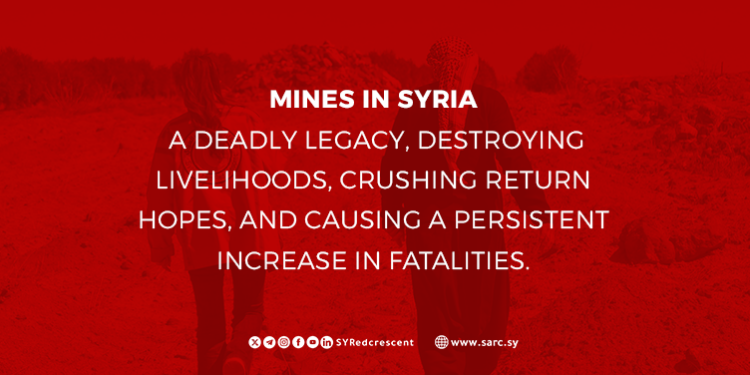Taha, 22, struggles to hold onto the memory of his family’s once-fertile land, a safe haven of his childhood, now transformed into a perilous landscape. He describes his family’s land in Deir ez-Zor’s Al-Huwaiqa neighborhood as littered with unexploded bombs, missiles, and various war remnants, a devastating legacy they encountered upon their 2023 return. This contamination prevents them from cultivating the land that once provided their vegetable needs and surplus. This loss of sustenance and security is a common thread woven through the lives of many Syrians.
Saleh, from Al-Bahlouniyeh in Homs, near the Lebanese border, recounts how he was forced to abandon his beekeeping, his sole income, four years ago due to the dangers of war remnants in his bee pastures. He now works as a laborer, pruning and grafting trees, to support his family, a situation shared by many in his village, trapped between mine threats and limited opportunities. Beyond the immediate loss of livelihood, the pervasive threat of mines casts a long shadow over entire communities.
The war’s legacy extends beyond lost livelihoods. UN estimates indicate a third of Syrian communities are at risk from unexploded ordnance. In Misraba, rural Damascus, Salim Idris describes farmers besieged by drought, rising costs, and the mine threat, forcing him to become a temporary laborer after losing his land. He expresses frustration at the limited effectiveness of paid mine clearance.
The danger of land access exacerbates food insecurity, impacting strategic crops like wheat, barley, and olives. Abu Daniel, 62, stopped cultivating his land near Sweida in 2013 due to nearby mines. Contamination of residential areas and infrastructure hinders access to services and safe returns. Khaled Raadoun, returning to Qalaat al-Madiq in Hama after seven years in northern Syrian camps, found his home destroyed and weaponized, delaying his family’s return. The impact of these explosives extends far beyond agricultural land, permeating every aspect of civilian life.
Uncle Abu Abdo’s return to Qalaat al-Madiq also turned to grief as he found his home uninhabitable due to damage and unexploded ordnance. He hopes for Syrian Arab Red Crescent intervention to assess and clear the area. The UN Mine Action Service (UNMAS) reports an average of six daily deaths or injuries from explosive ordnance since 2013. The Syrian Arab Red Crescent with cooperation with the ICRC documented 2,630 deaths and 3,731 injuries from 2019 to the beginning of 2025. These statistics, while staggering, represent only a fraction of the daily suffering endured by ordinary Syrians.
Ammar Amin, 32, lost his leg to a mine while fleeing to Hasakah in 2019. He hopes SARC awareness sessions will prevent further incidents. Incidents occur nationwide; Hassan Ali Muhammad in Quneitra lost his foot to a mine in 2019, impacting his ability to work. Mohammed Al-Mustafa, 22, lost his foot in Raqqa’s desert during truffle harvesting and now runs a small grocery store with SARC assistance. Each of these individuals represents a life irrevocably altered by the silent, deadly remnants of war, a legacy that continues to claim victims and shatter futures.
In response to this pervasive and deadly threat, the Syrian Arab Red Crescent, through its dedicated Humanitarian Mine Action Unit and with the vital support of the International Committee of the Red Cross, is actively working to mitigate the severity of this crisis. Their efforts are multifaceted, beginning with thorough needs assessments within affected communities to understand the specific challenges faced. They then implement widespread awareness campaigns, educating populations on the dangers of mines and war remnants, and equipping them with essential prevention methods. Crucially, they also establish safe play areas for children, providing a semblance of normalcy and security in otherwise perilous environments. Between 2017 and 2024, these critical awareness messages reached 1,400,349 individuals.
Furthermore, the Syrian Arab Red Crescent conducts non-technical surveys across key governorates—Homs, Hama, Aleppo, Deir ez-Zor, Rural Damascus, and Latakia—to identify and map dangerous and suspected dangerous areas. These surveys are essential for prioritizing clearance efforts and protecting vulnerable populations. Recognizing the long-term impact on victims, SARC also facilitates access to physical rehabilitation and prosthetics centers, and provides crucial support services, including medical and psychological care, relief assistance, cash grants, and livelihood opportunities. This holistic approach addresses both the immediate and enduring consequences of mine contamination.
Finally, to safeguard the continuation of the humanitarian operations, the Syrian Arab Red Crescent prioritizes the safety of its own staff and volunteers, providing comprehensive safety training. This commitment to safety underscores SARC dedication to serving those affected by the remnants of war, ensuring that hope and aid can reach even the most dangerous and forgotten corners of Syria.


